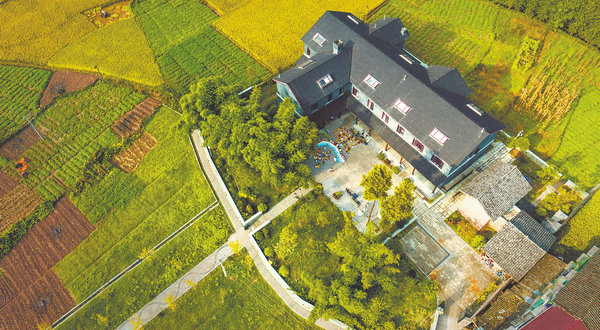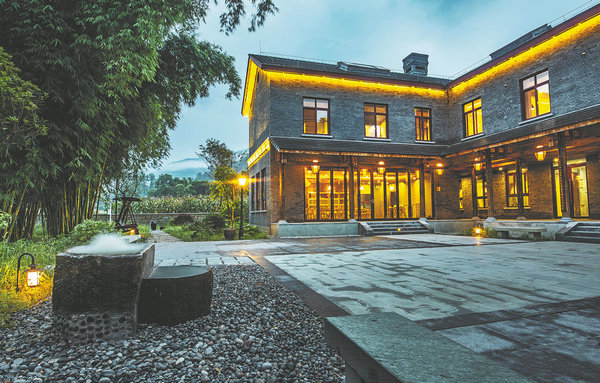
Bicheng village in Xuanhan county, Sichuan province, has been transformed into a hub of creativity, thanks to a rural vitalization project. [Photo provided to China Daily]
A village in Sichuan has been given a new lease on life with the founding of a center for rural arts, Yang Feiyue reports.
Asmall village that was finding it hard to retain its young people has not only reversed that trend but is now finding growing appeal with young talent from elsewhere.
Bicheng, tucked away in the depths of mountains, is located in the northeast of Xuanhan county, Southwest China's Sichuan province, as part of the environs of Baima town.
It is approximately 80 kilometers to the downtown area of Baima, and the nearest train station is a two-hour drive away.
Until recently, the majority of young people in the village would uproot themselves to pursue job opportunities in the cities, which meant the local economy and traditional culture were at a low ebb.
Everything changed when Xiang Yong and his brother decided to do something about their dilapidated family house in the village in 2015.
"The changing fortune of the village arose during a conversation with my father, as he was not happy about how things stood in the village where we were from," says Xiang, a professor from Peking University.
"Because we don't live there, our house had begun to fall apart. It looked quite rundown."
As Xiang and his brother had established themselves elsewhere, the father suggested they renovate the old house for their own descendants, so the offspring would have a reminder of where the family came from.
"He said the tree stands tall with roots extending a thousand feet, and the water flows thousands of miles from its source," says Xiang, recalling how sentimental his father was about their hometown.
Xiang and his brother, who is a businessman, decided to act on their father's wish.
However, Xiang believed that as well as renovating the house, it was also essential to come up with a way to utilize it, otherwise it would just deteriorate again.
"After all, we might go back only once or twice a year, and it would likely be a short stay each time," Xiang says.
"We regarded it as a waste and against our values if it were left idle."
Therefore, Xiang tapped into his expertise in cultural industries and set his sights on transforming the house into a multifunctional facility offering local culture, training and inspiration for young artists and makers from across the country and even abroad.
"We started by tapping into our family's past," Xiang says.
He traced and recovered historical items, such as correspondence with prominent educators left by his grandfather who attended the University of Nanking in today's Nanjing, Jiangsu province.
Xiang integrated them into the decoration of the family home to highlight the spirit of paying great attention to social advancement and doing charitable things such as raising money to dig aqueducts to benefit the locals.
At the same time, local ethnic Tujia elements and folk customs were incorporated into the new cultural facility.
Showcase for creativity
After several years of reconstruction, the property opened to the public in 2019. Since it sits amid farmland and fields of blooms, the two brothers named it the House of Florefields.
Arriving at the house via a narrow path and then ascending a few stone steps, one beholds walls crafted from gray bricks, river stones, and rammed earth. The eaves are supported by over 10 solid wooden columns, and the courtyard is paved with bluestone slabs.
The surroundings are embellished with emerald bamboo, green pine trees and red flowers.
The entire building draws inspiration from the architectural style of Peking University's Yannan Garden that was built in the 1920s, integrating the folk style of dwellings in the eastern part of Sichuan, Xiang explains.
"It blends art into the rural setting, allowing the courtyard to showcase cultural elements," he says.
The house has also been divided into zones, comprising a gallery, dining area and kitchen, artists' workshop, foyer and suite.
"We've created an exhibition that encompasses the local landscape, culture and folk customs, and showcases the development trends of rural cultural creativity both at home and abroad," Xiang says.
The gallery is open to local villagers and travelers for free.
It aims to display the long-term plan for rural vitalization development and encourage related parties to contribute to it, Xiang says.
The facility has 40 guest rooms and offers free accommodation for talent who can help with the development of the village.
Xiang says he and his brother want the house to play a role in fostering a community of international makers.
The artists' workshop is to serve as a creative space for them, so their work can also be applied to boost the village development, he says.
"Ultimately, we'd like to combine local traditions with the modern, creating a cultural life with distinctive local style and cultivating some micro businesses, such as promoting local honey, liquor, handmade crafts, and delicacies under a cultural brand," he adds.
Ever since its opening, various events have drawn artists, experts and volunteers to the village.
At the Da Bashan Fringe Festival that was staged in the village in August 2019, well-known photographers were invited to record the scenery and culture in Baima, while young scholars shared their views on future rural development.
Other activities include an art and painting program to enhance the artistic appeal of the village environment through the creation of local miniature landscapes and wall murals.
Additionally, the Florefields Steam Classroom has been established to recruit young volunteers from various regions to immerse themselves in rural schools, fostering artistic thinking and cultural literacy among rural children.
"Most of my students, for instance, are engaged in the creative cultural industries, and they can help with the planning of events to be held at the village," Xiang says.
To date, the upgraded facility has received more than 600 makers' visits, each lasting for more than two weeks.
Model for rural vitalization
Huang Binbin from Beijing still remembers her first time setting foot in the village in the summer of 2019.
"The rice was just emerging in the furrows, with its leaf sheaths barely reaching the ankles," recalls Huang who was then a student at Peking University.
She enjoyed taking a stroll through the rice paddies, and the feel of stepping on the soft soil imprinted with farmers' footprints made her nostalgic about her own rural hometown in East China's Fujian province.
After she became familiar with local villagers, Huang was instantly drawn to their unadorned simplicity and unworldliness, especially the innocence of children.
Huang has since been volunteering at the village to help out with organizing various events, receiving guests and offering training to local children.
After graduation last year, she has worked full time for the rural vitalization project.

The House of Florefields blends art into a rural setting. [Photo provided to China Daily]
"I've seen how infrastructure has improved in the village, with the new wide tar roads, the bright solar lamps on the main paths, and the increasingly strong artistic vibe in the neighborhood," Huang says.
In 2022, Bicheng was named a provincial model for rural vitalization by local government.
"We've been approached by many regions hoping to apply the Baima model," Xiang says.
At the moment, Yaoli village of Huzhou city, in Zhejiang province, has adopted the development approach of Bicheng, and Huang is taking charge of overall operations.
Recently, the project has been accredited by the UNESCO as a teaching site for creative sustainable village development, which Xiang believes will help draw in more talent, boost international communications in rural development and contribute to Bicheng's development.
The goal is to activate rural resources with the contemporary concept of cultural creativity, explore new models of cultural and creative rural construction, thus awakening the dormant Chinese rural civilization, Xiang says.
"The essence of Chinese culture lies in its rural genes. The construction of rural culture should not be confined to external symbols but delve into the internal power of the rural genes, promoting public identification with the countryside culture in the digital society," Xiang says.
The countryside should not linger in the homesickness of children reminiscing about the past but should rely on its uniqueness to drive the future development of human civilization, he adds.
Editor Ⅰ: Zhang Wenwen
Editor Ⅱ: Wu Dan
Editor Ⅲ: Liu Guosong














